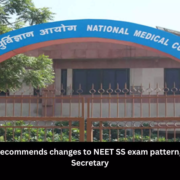Ajanta Pharma filed
the review plea under Para 31 of the Drugs (Prices Control) Order, 2013 against
the order issued on 06.01.2023 by the NPPA. The order fixed the ceiling price
of Metoprolol Tablet 25mg and Metoprolol Tablet 50mg.
Following
the submission, the Department of Pharmaceuticals sought clarification from
NPPA, leading to a hearing on June 1, 2023, where both parties presented their
arguments.
Ajanta
Pharma contended that NPPA has erred in determining the ceiling price of
the said drug and hence may be directed to revise the same.
The drugmaker challenged the impugned
notification in respect of ceiling price fixation of Metoprolol Tablet 25mg and
Metoprolol Tablet 50mg issued by NPPA as improper, misconceived as it has been
carried out erroneously, arbitrarily, without jurisdiction by NPPA, in
mechanical manner with wrongful inclusion of formulations manufactured by the
Applicant, namely Met XL 25mg Tablet ER 20 (Metoprolol 25mg Tablet Extended
Release) and Met XL 50mg Tablet ER 20 (Metoprolol 50mg Tablet Extended Release)
having modified dosage, incremental innovation and novel drug delivery system.
Ajanta submitted that it made
representation to NPPA on December 8, 2022 within stipulated time against draft
version displayed on its website on December 1, 2022, in respect of calculation
of Metoprolol 25mg Tablet for wrongfully including formulation Met XL 25mg
Tablet ER 20 (Metoprolol 25mg Tablet Extended Release) and Metoprolol 50mg
tablet for wrongful inclusion of Met XL50 mg Tablet ER 20 (Metoprolol 50mg
Tablet Extended Release), respectively, for ceiling price fixation under
revised Schedule-I of DPCO, 2013 as the said formulations manufactured by the firm
are distinct, separate and different and cannot be equated with the plain
conventional Tablets.
|
Sl. no.
|
Name of formulation
|
Scheduled
|
Dosage form and
Strength
|
Unit
|
Ceiling Price in IQs.
|
|
8
|
Metoprolol
|
|
Modified Release
Tablet 100 mg.
|
I Tablet
|
13.37
|
|
9
|
Metoprolol
|
|
Tablet 100 mg.
|
1 Tablet
|
9.93
|
Consequently, Metoprolol tablet
in plain/ conventional dosage cannot be clubbed with modified release dosage as
it would amount to be unreasonable, ultra vires, illegal, anomalous and not
tenable.
Prior to aforesaid amendment of the
DPCO, 2013 on 11 November 2022, earlier amendment in DPCO, 2013
was done via order dated 10th March 2016 in Schedule-I on the basis
NLEM, 2015 wherein Metoprolol tablet was listed at item no, the petitioner mentioned
in its submission.
Additionally, it pointed out
that in existing aforesaid Schedule-I of the DPCO 2013, Metoprolol 25mg and
Metoprolol 50mg plain tablets and sustained release tablets were specified
separately and as under:
Schedule-I National List of Medicines (NLEM) 2015
Section 12- Cardiovascular Medicines
|
12.1 Medicine used in Angina
|
|
|
|
Medicine
|
Level of health care
|
Dosage form(s) and strength(s)
|
|
12.1.7
|
Metoprolol
|
P, S, T
|
Tablet 25mg
Tablet 50mg
SR Tablet 25mg
SR Tablet 50mg
|
It claimed that NPPA had notified separate ceiling
prices of Metoprolol formulations plain/conventional tablets and modified
dosage sustained release (SR) vide SO. 1499 (E) dated 30.03.2022, as under-
|
Sl. No.
|
Name of
Formulation
|
Dosage and strength
|
Unit
|
Ceiling price in Rs.
|
|
561
|
Metoprolol
|
Capsule 25mg
|
I Capsule
|
4.70
|
|
562
|
Metoprolol
|
Capsule 50mg
|
I Capsule
|
7.16
|
|
563
|
Metoprolol
|
SR Tablet 25mg
|
1 Tablet
|
4.47
|
|
564
|
Metoprolol
|
SR Tablet 50mg
|
1 Tablet
|
6.41
|
|
565
|
Metoprolol
|
Tablet 25mg
|
1 Tablet
|
3.46
|
|
566
|
Metoprolol
|
Tablet 50mg
|
1 Tablet
|
5.24
|
The National Pharmaceutical Pricing Authority
(NPPA) has recognized that plain conventional Metoprolol tablets are distinct
from sustained-release (SR) and extended-release (ER) formulations by setting
separate ceiling prices for each, as outlined in Schedule-I of the National
List of Essential Medicines (NLEM, 2015), the petitioner stated, adding that
pricing for controlled-release formulations should only be considered if
explicitly listed.
It referred to the Hon’ble Supreme Court, in a 2019
ruling, that acknowledged the DPCO’s awareness of different drug delivery
systems, noting that modifications in drug release can enhance stability,
safety, and efficacy. The Court defined “sustained release” as a
system that maintains a consistent rate of drug release over time.
Additionally, the Delhi High Court ruled that price notifications for
conventional tablets do not apply to controlled-release formulations.
The pharma firm claimed that it is suffering
significant losses due to what it considers arbitrary price fixation in the
notification dated January 6, 2023. Therefore, it requested the reviewing
authority to withdraw this notification regarding Metoprolol 25mg and 50mg
Extended Release formulations or amend it appropriately.
NPPA
on the other hand argued that the instant review is not tenable as that the
pricing methodology followed was appropriate. According to NPPA, if a modified
release variant is not specifically mentioned, both conventional and modified
release data could be included in the pricing calculations. This approach
aligns with the methodology outlined in the National List of Essential
Medicines (NLEM) 2015, which aims to ensure the availability of essential
drugs.
The methodology
approved and followed for the pricing of MR Variant/Conventional Variant by the
Authority read;
“Wherever, MR variant is
specifically mentioned in any formulation the data of only MR variants (CR, SR,
XL, ER delayed release etc.) may be considered for fixation of ceiling price.
However, where MR variant is not specifically mentioned, data of conventional
as well as MR variants may be considered for ceiling price fixation. This is in
line with methodology of NLEM 2015 also. Similarly, where
DT/effervescent/soluble/MD, etc. is specifically mentioned in any formulation
in any formulation the data of only such variants may be considered. However,
in absence of any variant being specifically mentioned, the DT/ effervescent
/soluble/MD may be considered along with conventional form.
It further said that the NLEM is prepared with the
objective of satisfying the priority health care needs of the population. The
list is made based on disease prevalence, efficacy, safety and comparative
cost-effectiveness of the medicines. The aim behind formulating NLEM is to
ensure that these medicines are available in adequate quantity, in appropriate
dosage forms and strengths with assured quality. NLEM does recognize such
innovations in drugs where substantial improvements, effectiveness and efficacy
have been introduced either in terms of quality or in the delivery system or
both. Accordingly, NLEM mentions such innovative drugs separately under
different categories commonly named as Modified Release (MR) versions in the
same list where such criteria are fulfilled. When the same is not mentioned
separately, then all such varieties of such drugs for the specified dosages are
considered to be part of variants appearing in the list. The objective of NLEM,
inter alia, is to ensure availability of the essential drugs as well. This
objective may be adversely affected by the exclusion of different variants from
the NLEM based on criteria such as MR etc., as such exclusion may encourage
essential drugs simply moving out of NLEM. This may not be in line with the
spirit and purpose of including these drugs in the list of essential medicines
in the first instance.
Subsequently, the Department upheld the action of NPPA
fixing the ceiling price of Metoprolol Tablet 25mg and Metoprolol Tablet 50mg via
order dated 06.01.2023. The Review Application under
consideration was accordingly rejected.


















